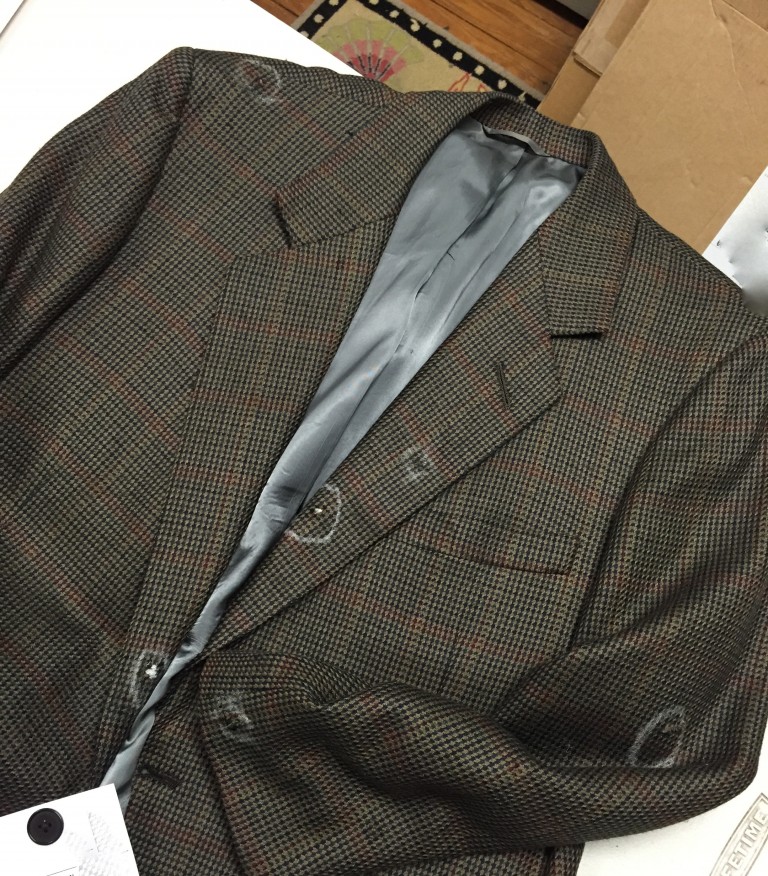How To Spring Clean Your Closet
It's that time of year again. Things are starting to get crowded in your wardrobe as your spring and summer clothes start to mix with the heavy winter clothes you still occasionally need to wear. All this wardrobe chaos signals its time for a serious spring clean.
Spring cleaning isn't just for the dark, dirty and unseen spaces in your house; your wardrobe also needs a serious going-over at least once a year, and the changing of the seasons in the spring is simply the best time to do it. You probably will already spend a few hours packing scarves, gloves, and sweaters into temporary storage, so why not use a little extra time to free up some extra space and money in your wardrobe?

Yeah, whose closet really looks like this?
A good spring cleaning should eliminate garments that have been taking up space (and money!) in your closet.
Spring Cleaning Process

You may not need to empty your closet entirely, but it can help if you are feeling indecisive
Step 1: Start By Getting Everything in Your Closet Out Where You Can See It
Open your closet doors and drawers, and get everything out where you can see. That means pulling out the contents of drawers, stacked piles, any clothes hanging out of sight in your closet, and anything that may have slipped into dark corners. Some guides will recommend taking everything out of your closet at once, but that might not be necessary; just make sure you look at each item with a critical eye before allowing it to stay in your closet. If you find that's not enough to really pare your collection down, then you can resort to taking it all out; it really does help you justify keeping what you put back in.

Keep light, spring colors and fabrics together in your closet
Step 2: Sort Every Item into Keep, Mend/Clean, Discard, and Donate Piles
Begin by sorting your clothes, section by section, into three piles. The clothes you want to keep should remain in your closet, but the other 3 piles should be Mend/Clean, Discard, and Donate.
- Donate clothes are gently used, relatively recent, and clean
- Discard clothes are 5+ years old, have visible stains, tears, they don't fit or you simply haven't worn the item in more than a year (special occasion items excluded)
- Mend/Clean clothes should include anything that you'd like to keep that need a repair work or an annual trip to the dry cleaner
Step 3: Rearrange Your Closet to Put Current Season Clothes Front and Center
Store off-season clothes appropriately, in garment bags or other storage, on high shelves or in other closets, so that they don't take space away from your day-to-day wardrobe.

Don't delay; bring your repairable shoes to the cobbler the same day
Step 4: Go to the Tailor, Cobbler and the Dry Cleaner the Same Day
It's easy to ignore random tasks like dry cleaning and mending, but since it's your spring cleaning day, make an effort to close the loop by getting your garments and accessories to the right place. Take shoes to the cobbler for new soles and a polish, get the sleeves of that spring coat shortened, and dry clean jackets before tucking them into winter storage.

Those pink GTH pants with whales may have seemed like a good idea at the time…
Step 5: Evaluate Your Discard/Donate Pile
Don't skip this important step! Inevitably, something in your discard/donate pile shouldn't have been purchased to begin with. While your work may seem "done", you should take some time to evaluate your discard and donate pile. Ask yourself: why is each item in this pile?
- Is the fit off, and the tailor can't fix it? (tight arms or body, too-wide shoulders, too short, etc?)
- Did the item not quite fit in with the rest of your wardrobe?
- Does the garment still have the tags on it, months or even years later?
- Did you have trouble finding ways to combine the garment in a way you liked?
- Did you buy the garment on a whim? because it was on sale?
- Did the garment wear out faster than you expected?
- Did the garment mysteriously end up with holes, fraying edges, or loose seams?
Regular aging and wear & tear aside, these questions should help you figure out why some things went into your wardrobe and then didn't pull their weight. Think of it this way: if you spend $50 on a shirt you don't wear, consider it "locking" a $50 bill in a box in your closet. If you had to make a decision to keep the $50 or the shirt on a regular basis, would you have kept the money or the shirt? Chances are you would have quickly taken the money back. Learn what things can easily cause trouble for you – sales, browsing, impulse buys – and try to avoid those things in the future.

50% suit sale – don't fall for this!
Our philosophy is quality over quantity, and while that isn't always an easy philosophy to follow in today's menswear marketplace, we believe that with a little persistence and research, your Spring Cleaning can be smaller season over season.
Step 6: Discard & Donate the Remaining Items
You're down to the final stretch. Your closet is clean, neat and organized. Now it's time to stick to your guns and discard and donate everything you've sorted out of your wardrobe. Not sure you're ready to do that? Toss everything into dark trash bags (not clear ones you can see through!) and tuck them into an out-of-the-way closet. Leave them there for a couple weeks, and then think – what items do I wish I had back in my closet? Chances are you won't remember what's in those bags and you can deliver them to the donation center with ease.
Put Your Spring Wardrobe to Work
Need some inspiration to start the wardrobe transition between seasons? Here are some great articles and videos to help you get into the new season:
14 Spring Wardrobe Essentials
Spring Fashion Illustrations
Spring & Summer Accessories
Denim Jeans Guide
Blazer Guide
Fresco Fabric: Perfect for Summer Suits
8 Secrets of a Great Summer Sport Coat
Summer Shoe Guide
Boat Shoes Guide
Mocassin & Driving Mocs Guide
How to Save Favorite Garments from the Discard Pile
Have the throw something away due to its age or some kind of damage? It may still be salvageable if it's one of the items below.

You can save a favorite blue shirt by turning it into a Winchester with white cuffs & a collar
- Shirts. Have a favorite shirt that fits like a dream, but is showing it's age? Shirts typically fray at the edges of the collar and cuffs, but if the body of the shirt is still in good condition, it can be saved by replacing the collar and cuffs. This requires sacrificing another shirt for the parts, but that may be a small price to pay to keep wearing your favorite shirt. In fact, whenever you contemplate discarding a shirt, trim off any expensive mother of pearl buttons (no need to do this with plastic) and cuff-collar sets that are still in good shape so that future shirt repairs are simplified.
- Anything with missing buttons. Lost a button on your favorite overcoat? Don't discard the entire garment; first, check inside the lining to see if another is sewn in for just this situation. If not, head to your local fabric supply store, eBay or Etsy and find a new set of buttons for your coat, including cuff buttons. Have your alterations tailor replace them, and your coat will be like new again.
- Sweaters. Even though a hole in your favorite knit sweater may seem like a fatal blow, they can be fixed if they are valuable to you. Holes in the elbows can be covered up with elbow patches by your alterations tailor. Holes elsewhere can be "re-knitted" by pulling threads from other parts of the sweater, but this service is quite specialized and may require shipping your sweater to an expert. Check in your local area for sweater re-knitting services, or see the links in the next section.


- Jackets. In the same way that a sweater can be re-knitted, jackets can also be rewoven. This does require an expert, but it may be worth seeking one out for a special piece. We haven't had a chance to test out either of these services personally, but some options are Knitwear Doctor, Without a Trace or Amazing Garment Repair. Most men's fabrics can be repaired except for nylon, corduroy, velvet and silks.
- Pants. Pants tend to be the most easily damaged along the pockets and hems, where they can pull, fray, and be stepped on. If you have enough fabric in the side seams, pocket tears can usually be repaired, and since they are in a less conspicuous location, they don't need to be eye-clean. Hems can be shortened to cover fraying edges and they can also be rewoven.
Other Steps to Consider When Spring Cleaning
You're already in the mood to make some changes. Frustrated with wrinkled, puckered or clothes that seem to emerge from your closet unwearable? It's time to update your Wardrobe Maintenance Essentials or replace your Closet Organization System. Tired of feeling like you NEVER have anything to wear, despite having a full closet? Or, are you prone to wear the same 5 things over and over again? If so, trying a Capsule Wardrobe may be right for you.
Conclusion
How do you go about your spring cleaning? Do you make it an annual wardrobe ritual, or do you prefer to do it bit by bit?
How To Spring Clean Your Closet
Source: https://www.gentlemansgazette.com/spring-cleaning-your-wardrobe/
Posted by: branchcouchisem.blogspot.com

0 Response to "How To Spring Clean Your Closet"
Post a Comment